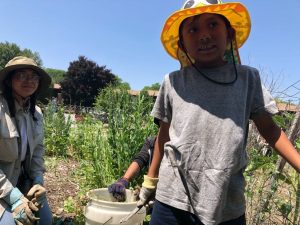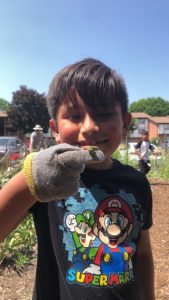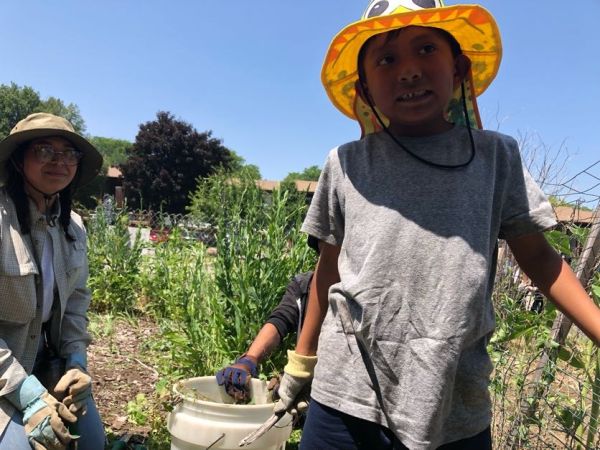
Monitoring, Planting, and Pulling – CLIP Week 3
by Kate Mikkelson
Monday 6/19
We started our week with a visit to Pistakee Bay, which is a property that’s owned and managed by TLC. We met with Randy Schietzelt who helped teach us how to monitor conservation areas like Pistakee Bay. We recorded every plant (native, non-native, and invasive) and every animal and insect. We also noted any man-made structures or disturbances; we found an old shed that needed to be removed, and some trash that had washed up. Land monitoring is super important to ensure that the ecosystem is healthy and that no one is violating the rules such as dumping lawn waste on the property (which may seem harmless to some, but can cause damage by snuffing out other plants).
After we completed our monitoring and compiled our data we prepared for the project we’d be working on the next day, Tuesday.
Tuesday 6/20
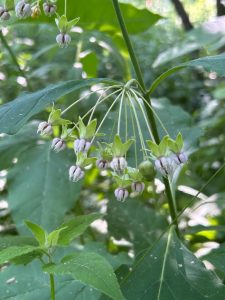
For the first half of the day, we headed to a top-secret location to monitor some rare plants. We were monitoring poke milkweed which is on the plants of concern list. We split up into groups and spread out to find as much of the poke milkweed as possible! We noted the environment in which they were growing and any factors that could affect the plant’s growth including the soil conditions, the plants growing around it, and any evidence of deer grazing. It is important to monitor these rare plants to not only see how they are spreading but also to monitor if there are signs of diseases or if they are being overrun with invasives so that there can be an intervention to help the plant thrive. We were led by Bruce Kessler, who is the steward for this piece of land. He has been working at this property for quite a while now, and it’s clear how much time and energy he has put into it.
After we finished our plant monitoring we met up with a group from the Youth and Family Center of McHenry County to work on a pollinator garden that had been planted the year before. We also worked with some interns from the Environmental Defenders of McHenry County there. Every intern was matched with a few kids, and we got to work weeding the garden! To our surprise, many of the kids got really into weeding the garden. So many eager workers made it go by quickly, and before we knew it we were ready for the next step: mulching! We put the mulch (that we interns had delivered the day before) into some buckets and a wheelbarrow, and dumped it on the path that wound through the pollinator garden. That seemed to be the kids’ favorite part! Since we had done so much work to weed the garden it already looked so much better, and the mulch helped make it look even nicer. Seeing how all their hard work had paid off seemed to really motivate the kids. Once all the mulch was distributed, we interns helped teach the kids how to put new plants into the garden. It was super cool to see how invested so many of the kids got in the garden – I see a few conservationists in the making!
Wednesday 6/21
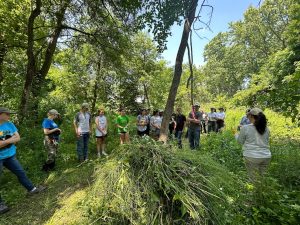
Wednesday was yet another day that was split into two parts. For the first part of the day, we met up with some volunteers from Crystal Lake South High School to do some invasive management at TLC’s Yonder Prairie. We pulled dame’s rocket and garlic mustard and put them into large piles to be burned later. We were split into a few groups, each group having two interns and around six volunteers each. Since we were split into groups, we decided to have a friendly competition to see which group could pull the most, which helped motivate everyone. It was a close call but after some careful deliberating, it was decided that Katie and Leah’s group had pulled the most!
For the second part of the day, we got to take a tour of Bluestem Ecological with Sarah Voska, David Stout and Eric Sebert. Bluestem is a for-profit company that helps people plant native in their own yards! Getting to talk with the people at Bluestem provided us with a different perspective on land conservation and taught us about some different career paths to take within land management and conservation. During our tour of the Bluestem grounds, we were introduced to several edible native plants, and we even got to sample a few!
Thursday 6/22
Thursday was a work day at the TLC’s York Conservation Easement, and we all got a chance to work on our chainsawing skills!
Friday 6/23
Friday was spent pulling wild parsnip at Gateway Nature Park. Wild parsnip is a nasty invasive that has photoreactive sap. If you get the sap on your skin and then the area with the sap is exposed to sunlight you could get a bad burn. While working with this plant, it is very important to cover as much of your skin as possible – which wasn’t ideal for the exceptionally hot day we were having.



